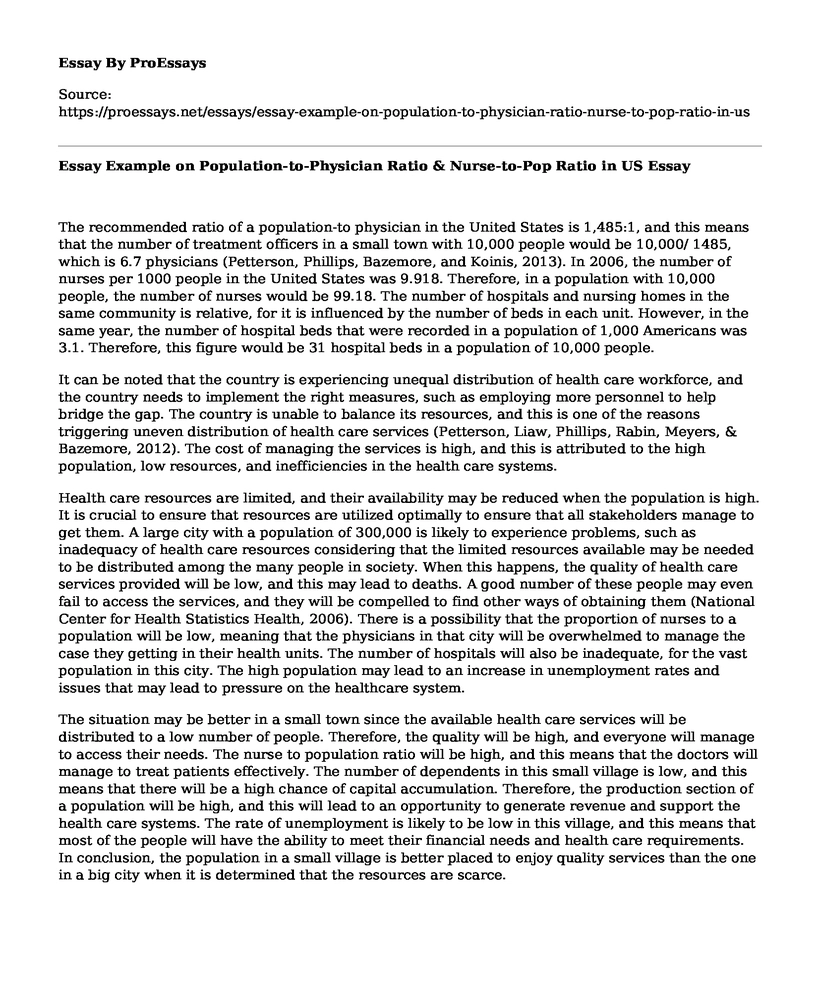The recommended ratio of a population-to physician in the United States is 1,485:1, and this means that the number of treatment officers in a small town with 10,000 people would be 10,000/ 1485, which is 6.7 physicians (Petterson, Phillips, Bazemore, and Koinis, 2013). In 2006, the number of nurses per 1000 people in the United States was 9.918. Therefore, in a population with 10,000 people, the number of nurses would be 99.18. The number of hospitals and nursing homes in the same community is relative, for it is influenced by the number of beds in each unit. However, in the same year, the number of hospital beds that were recorded in a population of 1,000 Americans was 3.1. Therefore, this figure would be 31 hospital beds in a population of 10,000 people.
It can be noted that the country is experiencing unequal distribution of health care workforce, and the country needs to implement the right measures, such as employing more personnel to help bridge the gap. The country is unable to balance its resources, and this is one of the reasons triggering uneven distribution of health care services (Petterson, Liaw, Phillips, Rabin, Meyers, & Bazemore, 2012). The cost of managing the services is high, and this is attributed to the high population, low resources, and inefficiencies in the health care systems.
Health care resources are limited, and their availability may be reduced when the population is high. It is crucial to ensure that resources are utilized optimally to ensure that all stakeholders manage to get them. A large city with a population of 300,000 is likely to experience problems, such as inadequacy of health care resources considering that the limited resources available may be needed to be distributed among the many people in society. When this happens, the quality of health care services provided will be low, and this may lead to deaths. A good number of these people may even fail to access the services, and they will be compelled to find other ways of obtaining them (National Center for Health Statistics Health, 2006). There is a possibility that the proportion of nurses to a population will be low, meaning that the physicians in that city will be overwhelmed to manage the case they getting in their health units. The number of hospitals will also be inadequate, for the vast population in this city. The high population may lead to an increase in unemployment rates and issues that may lead to pressure on the healthcare system.
The situation may be better in a small town since the available health care services will be distributed to a low number of people. Therefore, the quality will be high, and everyone will manage to access their needs. The nurse to population ratio will be high, and this means that the doctors will manage to treat patients effectively. The number of dependents in this small village is low, and this means that there will be a high chance of capital accumulation. Therefore, the production section of a population will be high, and this will lead to an opportunity to generate revenue and support the health care systems. The rate of unemployment is likely to be low in this village, and this means that most of the people will have the ability to meet their financial needs and health care requirements. In conclusion, the population in a small village is better placed to enjoy quality services than the one in a big city when it is determined that the resources are scarce.
References
National Center for Health Statistics Health, United States With Chartbook on Trends in the Health of Americans. Hyattsville, MD: 2006. Center for Disease Control Prevention. Retrieved from https://www.cdc.gov/nchs/data/hus/hus06.pdf
Petterson, S., Phillips, R., Bazemore, A., Koinis, G. (2013, 1 June). Unequal Distribution of the U.S. Primary Care Workforce. American Family Physician. Retrieved from https://www.graham-center.org/rgc/publications-reports/publications/one-pagers/unequal-distribution-2013.html
Petterson, M., Liaw, R., Phillips, R., Rabin, L., Meyers, S., & Bazemore, W. (2012). Projecting US primary care physician workforce needs: 2010-2025. The Annals of Family Medicine, 10(6), 503-509. Retrieved from https://www.ncbi.nlm.nih.gov/pmc/articles/PMC3495923/
Cite this page
Essay Example on Population-to-Physician Ratio & Nurse-to-Pop Ratio in US. (2023, Mar 26). Retrieved from https://proessays.net/essays/essay-example-on-population-to-physician-ratio-nurse-to-pop-ratio-in-us
If you are the original author of this essay and no longer wish to have it published on the ProEssays website, please click below to request its removal:
- Courts' Challenges: Underfunding Essay Example
- Essay Example on Rise in Military Spending: US Dominates, China Follows
- Essay Sample on Advanced Practice Nursing: Education Requirements and Benefits
- Paper Sample on Diagnosing L.P. with Chronic Fatigue Syndrome (CFS): A Case Study
- Walter Reed Psychological Center: Multidisciplinary Behavioral Health Care in San Diego - Report Example
- Paper Sample on Infant-Mother Attachment: Exploring the Secure Base
- Reducing Ventilator Infections: Establishing Intents for the Capstone Project - Paper Sample







